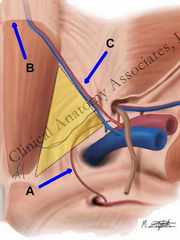Franz Kaspar Hesselbach (1759 – 1816). German physician, surgeon, and anatomist. Hesselbach was born in Bavaria in 1759. At the age of 19 he became an apprentice to Karl Von Siebold (1736 - 1807), a German surgeon, obstetrician and anatomist. He worked with him as an unpaid assistant for six years until 1789 when he was hired as a prosector.
Hesselbach became a lecturer on anatomy at the University of W?rzburg and a surgical assistant at the Juliusspital at W?rzburg. Later Hesselbach became a professor of Surgery at the same university.
Hesselbach’s name is eponymically tied to many structures, most of them related to hernia, an area where he is best known. In 1806 he published a treatise on hernia (Anatomisch-chirurgische Abhandlung ?ber den Urspurng der Leistenbr?che) “Anatomical and surgical treatise on the origin of Hernias”. These structures are:
- Hesselbach’s fascia: the cribriform fascia covering the saphenous hiatus of the thigh
- Hesselbach’s ligament: also known as the interfoveolar ligament
- Hesselbach’s triangle: site for direct inguinal hernia
- Hesselbach’s hernia: a femoral hernia protruding through the cribriform fascia
Hesselbach also described the femoral hernia in 1798 and distinguished between direct and indirect inguinal hernias.
In 1807 Hesselbach’s contributions were acknowledged and he was conferred the degree of Doctor of Surgery. During his life Hesselbach published several books, treatises, and papers.
A depiction of Hesselbach has not been found (yet) so we publish an image of his eponymic “triangle”. If you click on the image, you will see an original image from Hesselbach's book.
Sosurces:
1. "Franz Kaspar Hesselbach (1759–1816): Anatomist and Surgeon" R. Shane Tubbs et al W J Surg (2008) 32:11 2527-2529
2. "Groin Hernia Anatomical and Surgical History" McClusky DA, et al Arch Surg. 2006; 141(10):1035-1042
3. "Eponyms in groin surgery" Ellis, H. Surgery (Oxford) (2006) 24:8, 257–259
4. "Franz Kaspar Hasselbach (1759–1816)" Agarwal, AK; Mukherjee, R. Indian J. Surg (2008); 70:96–98
Primary Image property of: CAA.Inc. Artist: M. Zuptich.




